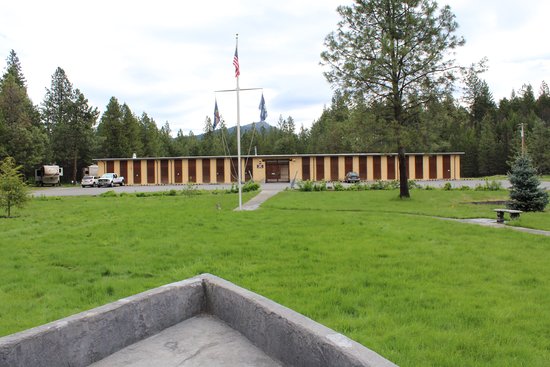


Farragut State Park is a public recreation area located at the southern tip of Lake Pend Oreille in the Coeur d'Alene Mountains of the Idaho Panhandle in the northwest United States. The 4,000-acre state park is five miles east of Athol in Kootenai County, about thirty miles northeast of Coeur d'Alene.
Once a World War II-era naval training station, this 4,000-acre park now provides camping opportunities with 223 individual sites, 10 camping cabins, and 7 group camps.
Located in the Idaho panhandle, Farragut State Park was once the site of the second largest WWII naval training facility in the country. At its peak the base housed over 100,000 people and included the largest hospital in the Pacific Northwest. Today the foundations of some former buildings, as well as the relatively intact brig are all that remain of this once bustling base.
And as with many historic buildings with a colorful history, rumblings of paranormal activity in and near the former brig pepper the media. Haunted or not, it’s still a great destination for anybody interested in WWII history; and as an added bonus, it also boasts a comfy wheelchair-accessible camping cabin perched on the shore of Lake Pend Oreille.
Although far northern Idaho seems an odd location for a naval base, there’s a sound reason behind the choice. Safety. After the attack on Pearl Harbor, the powers that be wanted a base site that was impervious to air or sea attacks. And since this chunk of real estate between Coeur d’Alene and Sandpoint is surrounded by mountains and far from the ocean, it proved an excellent choice.
Named after the famous admiral, Farragut Naval Training Facility occupied over 4,000 acres at its peak. Recruits would arrive in cattle cars and complete 13 weeks of basic training with classes in seamanship and warfare. Field training for gunners consisted of recruits firing wooden “practice shells” at navy aircraft as they swooped down over Lake Pend Oreille. And after they graduated they were sent into battle.
Recruits that broke the rules ended up in the brig. Most inmates were housed in four- or six-man cells, and were were assigned to hard labor, which included smashing boulders into gravel with sledgehammers, or sawing firewood by hand. Those that were convicted of more serious offenses were held in solitary confinement, until they were transported to the federal prison in Treasure Island, CA.
The base was also home to German POWs in 1945. They were treated as soldiers, not prisoners and assigned landscaping, firefighting and cooking tasks. The POWs were not housed in the brig, but lived in separate quarters near the modern day entrance of Farragut State Park. They did however cook for prisoners in the brig, and it was reported that the quality of the meals greatly improved after their arrival.
Visit the Brig
The Museum at the Brig offers a good overview about life at Farragut Naval Training Facility. Accessible parking is located near the entrance, with level access to the courtyard, and barrier-free access to the brick cellblock. The exhibits begin with a short 20-minute orientation film which details the history of the facility. A few cells are set up as they would have been in WWII times, while others contain exhibits about the building of the facility, the training the took place there, and the social lives of the workers and recruits. There are also exhibits about the POWs and the WAVES, as well as a good overview of WWII. Throw in a large collection of weapons, uniforms and personal items of the recruits, and you have a comprehensive look at life at Farragut Naval Training Facility.
Don’t miss the vintage vehicles on display in the courtyard, and the historic exhibits in the opposite wing. And if you have kinds in tow, be sure and stop in at the junior ranger activities center on the far side of the courtyard.
Save some time for a short visit to Memorial Park, located across the street from the brig. There’s barrier-free access to the small park which features a unique statue of a sailor. The bust stares soberly into space, while smaller faces of a multitude of sailors cover his face. It’s said to represent the different recruits that help make a soldier during his training.
The Syringa camping cabin at Farragut State Park
In contrast to the stark brig, the Syringa camping cabin offers a pleasant spot to spend the night at Farragut State Park. It’s located near the end of the South Road, nestled in a forest that overlooks Lake Pend Oreille. There’s no accessible parking for the cabin, but there’s level parking in the asphalt lot next to the accessible vault toilet. From there it’s a 200-foot walk on a level sidewalk to the cabin. Alternatively you can parallel park in a level area about 150 feet from the cabin.
There’s ramp access to this basic camping camping, which includes a spacious deck with a swing and a table. The cabin features a wide front door and plenty of room to maneuver a wheelchair inside. It’s furnished with a simple 17-inch high double bunk bed (bring your own bedding) and a table with two benches. It also includes lights, an air conditioner and an electric outlet.
No cooking is allowed inside the cabin, but there’s a large accessible table and a raised fire ring next to the deck. All in all it’s a comfortable and affordable place to spend the night. Even better — since there are only four cabins in this area of the park, and the gate closes at dusk, you’ll almost have things to yourself at night.

